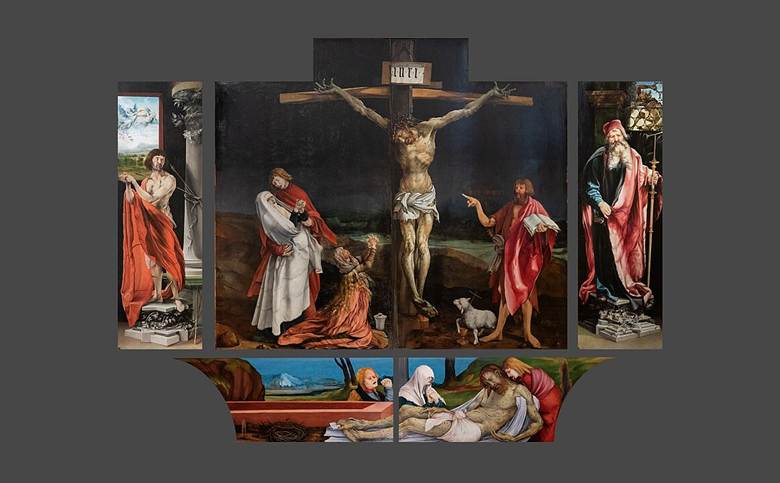Having visited a lot of churches with our four kids, my wife and I have had to explain a lot of images.
To my six-year-old daughter, I explained that the Eye of Providence at St. Mary Major, which is often taken as Masonic, was a magnificent symbol of the Trinity’s vigilant gaze over creation. To my seven-year-old son, the golden rays emanating from the alabaster dove in the apse of St. Peter’s represent the glorious power of the Holy Spirit. To my four-year-old daughter, the muscle-bound figure at the center of Michelangelo’s Last Judgment in the Sistine Chapel represent Jesus, as merciful as He is just. And to my two-year-old, I explained the wrath of Moses in St. Peter’s in Chains, Michelangelo’s astonishing sculpture of the seated prophet exuding zeal for God’s law.
What surprises me is that we’ve never had to explain an image of the cross to my children, and they’ve seen lots of them, from the cross that spoke to St. Francis in San Damiano to the one that spoke to St. Thomas Aquinas in San Domenico. My children seem to understand the cross as an expression of love so intuitively that I wouldn’t be surprised if Christ speaks from it to them too.
I realize that, to a certain extent, it’s because they hear us telling them repeatedly the story of Christ’s passion, and they absorb all kinds of biblical stories prefiguring the cross. Nevertheless, to an adult, it seems almost counterintuitive that the horrific punishment of crucifixion could speak so readily of God’s love to a child.
On the other hand, when we read St. Thérèse of Lisieux’s autobiography, we see that childlike holiness and the cross go hand in hand. The spiritual insight that led to her vocation within a vocation was that suffering is the preeminent means of coming outside of oneself and giving oneself to others. “As Jesus had made me realize that the Cross was the means by which He would give me souls, the more often it came my way, the more suffering attracted me.”
It would be extraordinary—though not impossible—for a young child to comprehend that connection between suffering and charity so deeply, but, at the very least, children do not find it difficult to make the connection between the cross and the gift of self to others. “Jesus died for us,” my two-year-old says every time she sees a cross. The image doesn’t just recall for her the fact that Jesus died, but that Jesus died for us.
It may be that the idea of the cross as weakness only creeps in when we become adults. “The message of the cross is foolishness to those who are perishing, but to us who are being saved it is the power of God,” writes St. Paul (1 Cor. 1:18). Paul directly relates the message of the cross to our spiritual state of dying or living. By gazing on the exalted cross, we find an antidote for the sickness of sin (cf. Jn. 3:13-17), but our very experience of being saved also allows us to see the cross as a message of God’s power (cf. 1 Cor. 1:17-25).
I’ve found this so true that my children can accurately interpret even Grünewald’s Isenheim altarpiece (1512-1516), an especially gruesome and deeply moving portrayal of the crucifixion.


They haven’t seen it yet in person, but a colored plate in one of our art books gives them a close enough look. The pathos evoked by the piece is particularly attributable to the monks’ care for the ill at St. Anthony’s Monastery. The Christ figure in the center of this triptych is covered with the oozing sores of plague victims, highlighting Jesus’s ability to identify completely with their affliction. My daughter, however, was mesmerized by Christ’s fingers and hands, not so much for their contorted position but the intricate realism with which Grünewald painted them. She’s equally drawn to the hands and fingers of St. Mary Magdalene on Christ’s right and John the Baptist’s on His left.
The nails driven through Jesus’s palms transfix His hands in a quintessential orans position, representing His perfect sacrifice to the Father as an ultimate prayer. “Consummatum est” (Jn. 19:30). “Father, it is finished.” As the Church fathers point out, the meaning of these, Jesus’s final words, indicate that His death is definitive, His mission completed, His prophecy fulfilled, and His sacrifice acceptable. All that is somehow mysteriously perceived by a child in silence. Many sacred images need to be explained, but apparently the cross does not.
My children join the Little Flower in reminding me that spiritual perfection can only be attained in a childlike state. “Unless you turn and become like children, you will not enter the Kingdom of heaven” (Mt. 18:3). Add to that St. Paul of the Cross’s conviction that “in the Cross is the perfection of holiness,” and we have everything we need to know about the importance of the Feast of the Exaltation of the Holy Cross.
Image from Wikimedia Commons
















